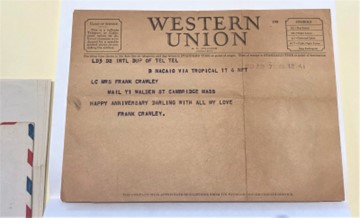By Susanna Sigler, Library Assistant
One of my first directives when I started at the MHS as a library assistant back in May was to begin to familiarize myself with using the ABIGAIL interface. This is how I found myself searching for materials on topics of interest to me, including the (admittedly very broad) topic of WWII.
I found in ABIGAIL that the MHS holds many collections related at least in some way to WWII — although it is a small fraction of the larger holdings — and is currently working to acquire more. Somewhat randomly, I picked the papers of Cambridge resident Frank T. Crawley to investigate further.
The record in ABIGAIL explains that these letters were largely to Frank’s fiancée Christine, and that they cover a variety of subjects, many related to his time stationed in the Panama Canal Zone with the U.S. Marine Corps. The memory of WWII in the United States today has ascended to a status that is almost beyond reproach, a kind of veneration expressed in severe memorials and Serious Dramas. I was interested in the experiences of Frank, who like many Americans serving in the war, did not see combat.
One topic in particular also caught my eye — “his love for her.” I was intrigued by what that might look like. Real WWII love letters, the stuff of movies. Some special, more pure kind of devotion that people insist does not exist today.
Having taken a dive into the beginnings of this collection of correspondence, I feel confident in reporting that couples in the 1940s were very much the same as they are today, differences in slang notwithstanding. “Swell” and “grand” are common adjectives, “gee” is peppered throughout, his nicknames for her are a carousel of darlings, honeys, and sweethearts. His proclamations are often and strong, that he misses her, that he loves her, that her happiness means everything to him and that he wishes the war were over so that they could be together.

Your love keeps me going and keeps my heart warm. Darling you’re so sweet and thoughtful and I’ll never stop loving you no matter where I am or who I am.
Additionally, a member of Frank’s family or from Christine’s makes their way into the mix. There is a whirlwind of a letter from Frank’s sister-in-law Marie, who, in her update to Frank, had become an American citizen, obtained her driver’s license, and was on her way to becoming a 2nd Lieutenant in the Red Cross Motor Corps, all in quick succession.
Frank and Christine marry on June 6th, 1943, one year prior to D-Day. On their anniversary, Frank sends a telegram, as well as a letter. About D-Day he writes,
Darling it looked like General Eisenhower waited for your big day to put on his show and from the radio reports it is going along quite successful and I hope and pray that Germany will be knocked out in a hurry. We are all so darn sick of this war and the sooner it ends the better.

Though the vast majority of the letters are from Frank, there are scattered replies from Christine in which she returns his sentiments, thanking him for his latest “sugar report,” and updates him on events back home.

Honey, you wrote that you had seen the Andrew Sisters in “Always a Bridesmaid.” Jo & I saw that Monday night, a few days after you did. You seem to see the same pictures we have playing at the local theatres. It’s fun hearing we’ve seen the same pictures at almost the same time. Somehow, it feels as if we had seen them together. — almost.
There are many passages that are similarly moving, so much so that it only really hit me about halfway through the second box of letters that that was what I was reading — someone’s personal correspondence. These were words that presumably Frank didn’t think anyone besides Christine, and possibly her family, would ever see (well, besides the censor).
In some ways it feels even more like an intrusion due to the letters’ relative recency. Frank and Christine were about the same age during the war as my grandparents. Their letters feel more personal than looking at business papers, or those of a noted head of state. These are Frank and Chris, who love movies and baseball and talk about how desperate they are to see each other on the rare weekends he’s allowed during training. Even the fact that I’m casually referring to them by their first names and nicknames, these people I’ve never met, feels like something that really only happens in an archive.
Ultimately, this collection helped me continue with what I set out to do — familiarize myself with the MHS catalog and the reading room handling guidelines. It also fueled my interest in exploring more collections related to WWII, and to start compiling information for a potential subject guide that researchers could use. But it also made me pause, and remember the intense personal nature of manuscript collections — all manuscript collections — and just how a person’s life, and their most intimate relationships, can become “history.”
Citations
Christine Panariello Crawley to Frank T. Crawley, 10 March 1944, Frank T. Crawley Papers, Massachusetts Historical Society.
Frank T. Crawley to Christine Panariello Crawley, 13 February 1943, Frank T. Crawley Papers, Massachusetts Historical Society.
Frank T. Crawley to Christine Panariello Crawley, 7 June 1944, Frank T. Crawley Papers, Massachusetts Historical Society. “Research Starters: US Military by the Numbers.” The National WWII Museum. Accessed August 5, 2022. https://www.nationalww2museum.org/students-teachers/student-resources/research-starters/research-starters-us-military-numbers

